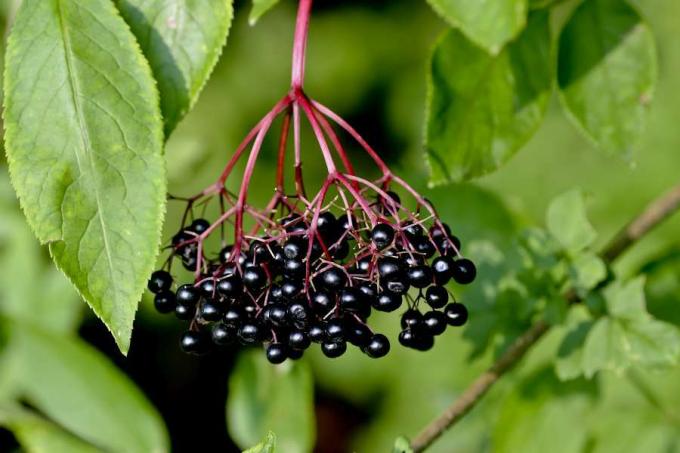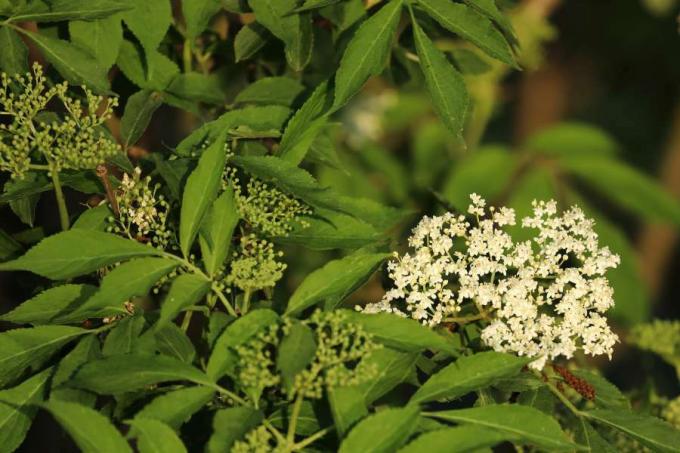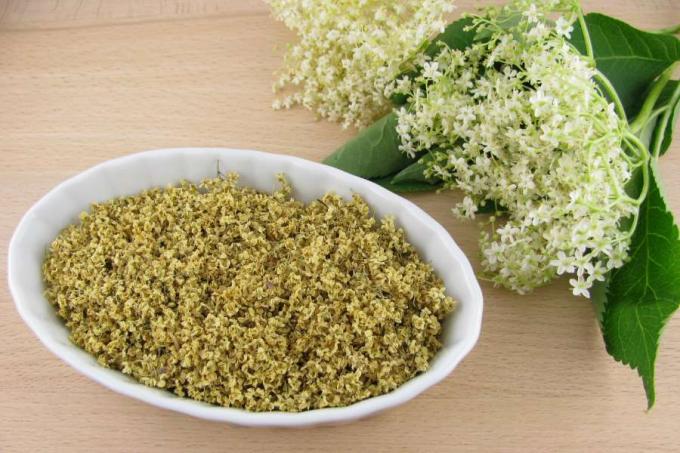When is elderberry ripe? How do you go about harvesting elderflowers and berries? What else can you do with elderberry besides elderberry juice? We give tips on harvesting, preserving and using.

Black elder (Sambucus nigra) can be used in many ways. Probably the best-known product made from elderberry is elderflower syrup. Perhaps you know it as an ingredient for the refreshing summer cocktail "Hugo". The special feature of the elderberry bush is that you can harvest and process both the flowers and the fruits. You can find out how to do this in this article. You can find more information about the elderberry bush - from planting, care and propagation to different types and varieties of elderberry - in our article about elder.
contents
-
When is elderberry ripe?
- Harvest time of the elderflowers
- Harvest time of elderberries
-
Harvesting elderberries: this is how you do it
- Harvest elderflowers
- Harvest elderberries
- Elderberry ingredients: Can you eat elderberries and flowers?
-
Use and preserve elderflowers
- Elderflower syrup
- Elderflower Liqueur
- Dry elderflowers
- Freeze elderflowers
-
Use elderberries & preserve them
- elderberry juice
- Elderberry syrup
- Elderberry liqueur
- Elderberry jelly
- Freeze elderberries
When is elderberry ripe?
Not only the ripe fruits of the elder can be harvested and processed, the flowers of the elder bush can also be used in different ways. However, it must be remembered that without flowers there are no fruits. If you want to harvest both elderflowers in early summer and elderberries in late summer, you can Only partially harvest the flowers of the elderberry bush, otherwise no fruit can form.
Harvest time of the elderflowers
The elderflowers bloom from the end of May to June and should be harvested as fresh as possible, i.e. shortly after the individual flowers have opened.
Harvest time of elderberries
The elderberries ripen between the end of September and October. Harvest the fruit only when as many berries as possible are ripe. Unripe berries should not be eaten due to their toxicity. In general, ripe elderberries must also be heated and boiled before consumption so that the toxic ingredients lose their effect.
tip: The elderberry bush is a very bird-friendly tree because of its fruits. It is therefore best to always leave a few elderberries for your chirping garden dwellers.
Harvesting elderberries: this is how you do it
If you want to harvest elderberries, you will need scissors or a knife and a basket or other container for the flowers or fruit. When you harvest the elderberries, it is advisable to wear dark and older clothes if possible, since the juice of the elderberries is very intense in color and elder stains are difficult to wash out are.
Harvest elderflowers
Cut the flower spikes on a sunny morning when the dew has dried on the newly opened individual flowers and place them loosely in a basket. Process the harvested elderflowers as quickly as possible, otherwise they will wither.

Harvest elderberries
Wait until all the berries are dark purple to black before harvesting the elderberries. In the case of red elder (Sambucus racemosa) ripening is reached when the berries are red. Cut the stalks and place them in a container, being careful not to burst the juicy berries.
Elderberry ingredients: Can you eat elderberries and flowers?
Elderberry has many healthy ingredients. In the Middle Ages it was an important medicinal plant and even today hot elderberry juice and tea made from elderflowers are common home remedies for a cold.
Elderflowers contain essential oils, tannins and mucilage, flavonoids, potassium and sweat-inducing glycosides. Elderberries are real vitamin bombs and, in addition to vitamins C and B2, also contain essential oils and flavonoids as well as anthocyanins, minerals and folic acid.

However, the leaves, bark and seeds in particular also contain toxic hydrocyanic acid glycosides. Therefore, the elderberries may only be eaten boiled. Red elderberry seeds have higher levels of toxic substances and do not lose them completely when cooked. In order to still be able to eat the elderberries, you should remove the seeds with a sieve.
Use and preserve elderflowers
Elderflower can be processed into various products. Here are some ideas for treats you can make from the creamy white flowers and how to preserve them.
Elderflower syrup
With just a few ingredients, you can create a delicious elderflower syrup from the flowers. In addition to the elderflowers, you need water, sugar and lemons or oranges. If stored correctly, the syrup can be kept closed for about a year. For example, you can enjoy it with Prosecco, mineral water and mint as "Hugo" or without alcohol as a refreshing elderberry lemonade.

Elderflower Liqueur
Elderflower liqueur can also be prepared quickly. In addition to elderflowers, water, sugar and lemons, you need a clear schnapps such as vodka or grain.
Dry elderflowers
If you want to drink elderflower tea in winter, you can easily dry the elderflowers after harvesting. Cut off the thicker flower stalks just before the first branch and then place the flower umbels on a wire rack or wire rack so that they are also ventilated from below. The elderflowers can dry in a shady, warm and airy place. Apply them daily. If the buds rustle when moved, that's a sign they're completely dry. At this point, you can pluck the individual flowers from the stems and store them in an airtight container, such as a jar, in a dark place for up to a year.

Freeze elderflowers
If you don't want to use the elderflowers immediately after harvesting, you can also freeze them. After you have shaken off any dirt and insects, briefly dip the harvested elderflowers in water and then let them drain. Spread the flower spikes out on a baking sheet or tray and place in the freezer for a few hours. You can then pull the individual flowers from the stems and store them in suitable containers in the freezer.
Use elderberries & preserve them
If you have not harvested all the elder flowers in early summer, you can harvest the fruits of the elder bush in late summer. The elderberries can also be used in many ways.
elderberry juice
After harvesting, you can process the elderberries into juice. First separate the washed berries from the stalks, for example by plucking them with a fork. Elderberries can only be eaten when cooked, as the poisonous sambunigrin they contain loses its effect when heated.

Elderberry syrup
With water, sugar and lemons, you can make elderberry syrup from elderberry juice, similar to elderflowers.
Elderberry liqueur
With sugar, vanilla and schnapps (like rum) you can process the elderberries into elderberry liqueur, which you can enjoy on its own or in an aperitif.
Elderberry jelly
Elderberry jelly is also a good way to process and preserve the elderberries. For this you need elderberry juice, lemon juice, preserving sugar and spices such as cloves or cinnamon.
Freeze elderberries
Elderberries also freeze well. Separate the berries from the stems with a fork and then freeze them. Alternatively, you can freeze the panicles for a few hours and then pluck the berries. In this way, elderberry juice stains can be avoided.
If you would like to learn how to properly prune the elderberry bush so that you can look forward to a bountiful harvest year after year, we recommend our special article on the topic "Cut elderberry“.
